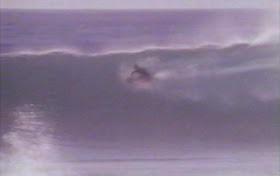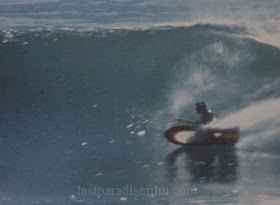About 15 years ago (?) I wrote a short piece on Velo for The Surfer's Journal. They were publishing a feature on the current state of the kneeboarding art, and were looking for an historic counter-point to the modern scene.
I know we've been through this before, but here's another bite at the Velo apple, along with some images added that weren't in the original article...
------------------------------------------------------------------------
FAR OUT FLEXIBLE SURFBOARD -- WAVE OF THE FUTURE?
"That was the headline that topped a feature on George Greenough in the August, 1969 issue of Popular Science.
Yup. Popular Science. The article was a thinly disguised promotional piece for The Fantastic Plastic Machine, and George’s flexible spoon kneeboard, Velo, was the “scientific” focus of attention. What made this story worth noting was the unblinking conclusion that someday all surfboards would be flexible like George’s.
I know we've been through this before, but here's another bite at the Velo apple, along with some images added that weren't in the original article...
------------------------------------------------------------------------
FAR OUT FLEXIBLE SURFBOARD -- WAVE OF THE FUTURE?
"That was the headline that topped a feature on George Greenough in the August, 1969 issue of Popular Science.
Yup. Popular Science. The article was a thinly disguised promotional piece for The Fantastic Plastic Machine, and George’s flexible spoon kneeboard, Velo, was the “scientific” focus of attention. What made this story worth noting was the unblinking conclusion that someday all surfboards would be flexible like George’s.
Not short like George’s.
Not a kneeboard like George’s.
But flexible.
It was a magnificent twist of fate that
someone of George’s imagination and intelligence would find his
voice, surfing-wise, in kneeboarding. As a member of a yachting
family who took frequent jaunts to destinations like the Hollister/
Bixby Ranch and the Channel Islands, George’s surfing developed in
a rarefied atmosphere. He shaped small, balsawood kneeboards to ride
deep inside the hollow waves he was privy to...
...and at one point, he
made a fiberglass fin that flexed like a fish’s tail.
The flex fin
improved his kneeboards performance so dramatically that he began to
conceive of an entire board that could bend in a similar manner.
George’s first flexible fiberglass
spoon was made in 1965.
It was a turn key ripper. After riding it for
a year or so, he took the knowledge he had amassed and built ''Velo Super Sport Mark II.''
It
was wider than the original, and he increased the depth of the
displacement hull under the nose. The severe belly allowed George to
bury the entire rail in a turn, and the parallel outline gave him
something to drive off on as the fin and tail flexed out of the way.
In trim, the drag of the hull allowed the nose to be drawn into the
juiciest part of the wave, while the large fin counterbalanced that
effect, driving the board down the line like a sail.
In many ways, Velo surfed itself. There
was rarely a conflict between where George wanted to go and where
Velo was already headed. While the shape appears to be simple at
first glance, it’s very complex. The close proximity of Velo’s
deep displacement hull under the nose to its dead flat planing area
just ahead of the fin is one of the unique aspects of the design.
There is a remarkable degree of transition compressed into just five
feet of board length.
During the mid-60’s, George’s
performance on Velo ignited the surfing world’s imagination. His
riding manifested a passion that had laid dormant in the hearts of
surfers for untold generations. He was able to confidently rip into
waves in the six to twelve foot range. A nasty pocket that sucked out
in front of him wasn’t something to be survived, it was an
opportunity. George could dive into the pit, pull Velo up onto its
rail, break the fin out, and explode through the section.
He began to
think of speed not in terms of making the wave, but in terms of what
gear he was running in. First gear was just enough speed to make it.
Second gear was enough speed to maneuver up and down while making it.
Third gear allowed him to attack a single section three times –
once as he rocketed over the top of it as it formed, a second time as he
cut back across it as it crested, and a third time as he tucked into
the tube as it pitched out. On big days at Rincon, he would link
together third gear charges from the Indicator to the sea wall. Often
bottom turning around sections that had already been broken down from
the track of his previous bottom turn!
The speed and power he had on tap were
directly related to Velo’s ability to bend in a turn. Flex allowed
Velo’s dead straight tail rocker to “give way” when it banked
over into a turn, facilitating any degree of directional change. Then
it would snap back straight as the turn leveled out, allowing the
board to accelerate down the line without the drag caused by tail
lift. Rocker-wise, Velo could morph from a gun to a hotdog board and
back again, and George could use each variation to its best
advantage.
Flexibility was a profound leap forward
in design knowledge, but one which conventional builders have never
been able to utilize to any significant degree. The materials don’t yet exist
that would allow a buoyant, stand up board to bend in the spring
steel like manner of a solid fiberglass kneeboard.
As great a Velo may be, it success is
qualified. It’s an extreme design that’s limited to perfect,
uncrowded waves....
...but flexibility has a universal application that
will be appreciated once the right material become available. And when
they do, all hell is going to break loose.
Velo was George’s favorite board of
all time, and he rode it for 4 years – 1966 through 1970. While he
built a number of displacement hull spoons during that period, none
had the performance – or the soul -- of Velo SS MK II.
Unfortunately, it was never
photographed operating at its peak. Surf movies that documented
George on Velo (The Fantastic Plastic Machine, Children Of The Sun, The Innermost Limits Of Pure Fun, The
History of Australian Surfing, and at least one of Bob Evans’
offerings) were either fleeting glimpses, or filmed in surf that
couldn’t adequately drive the board.
Hands down, Velo was the most
sophisticated piece of surf equipment ever built. It was so advanced
that even today, some 40 years after it was conceived, it serves as a
beacon of our destiny. Everything we’ve accomplished in
conventional design is merely preparation for the day when materials
will allow us to build a conventional surfboard that can flex in a proper manner...and Popular Science’s prediction that 'George Greenough’s
Far-Out, Flexible Surfboard Is The Wave Of The Future' will finally
come to pass."

















No comments:
Post a Comment